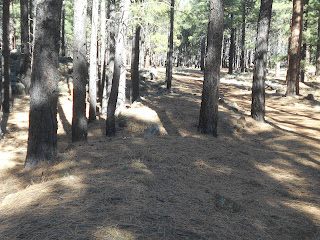BELLEMONT LINE: BRANNIGAN TANK TO SEVEN ANCHOR TANK, FR9001N, 81B
The Brannigan Tank area was covered in the March 19, 2020 Post. FR9001N is the spur heading north to the Seven Anchor Tank area. This area is part of Government Prairie, a protected place left to nature. The location blooms during the spring, and in the good years, various wild flowers bring forth their majesty throughout the summer months. "Even Solomon was not clothed with such splendor." It is also home to a variety of wildlife, such as elk and pronghorn antelope. Traveler beware: the roads across the Prairie can be very rough, and impassable during the monsoon season.
The following information may seem "preachy," nevertheless there are people who need to be reminded: please follow directions on posted signs. As stated in other posts, and continually repeated, do not destroy or desecrate historic sites. My posting regarding the Bellemont Line and Camp 2 area remains the same; digging things up and removing items from a historical site can result in stiff fines and imprisonment.
RED is the spur along FR9001N. The Dotted Red lines are spurs
indicated on early forest maps. YELLOW arrow points to Brannigan Tank.
LIGHT BLUE arrow highlights Government Prairie.
BLUE designates spur and loadout area.
At Government Prairie, looking towards one of the Government Knolls.
A herd of Pronghorn Antelope. Even though thousands of miles away, yet they act just like the antelope of the African plains. Being a nature reserve, the area is rich in wildlife.
Looking North across a portion of Government Prairie.
Kendrick Peak is in the distance.
The area of study is accessible by following FR9001N from Brannigan Tank (very rough and rocky in places,) or by taking FR81B from Government Prairie.
FR9001N is either on, or parallels the original spur as it heads north.
Grade and road as it ambles through the forest.
Remnants of the original roadbed, not covered by the forest road. Original construction techniques can be seen; logs were placed parallel to the line of travel, then covered by rocks and dirt to the desired level. Standard gauge trains traveled this line.
A slight ramp, just to the side of the forest road. At the top of the ramp is a clearing, where the spur diverges from FR9001N
Part of the clearing, where the spur cuts-off to the East. Thankfully, no one has used this log for their camp fire. Sometimes a downed log may look like a good candidate for a campfire, however it may also be a significant artifact of the early loggers. One-hundred-year-old ties were often consumed by fire, whether it was in a fire ring or in a forest fire. Whatever the case, they no longer mark the path of those early roadbeds, making it a challenge to document their route. Please think first before burning history.
The spur as it heads Northeast from FR9001N and the clearing.
The spur near the top of the hill, looking back on the line. As you can see, the grade becomes difficult to follow, and you could risk losing sight of it. Be careful and don't get lost. If it looks like you are getting lost, stop, turn around and head back.
The spur ends at the top of the hill, and there are no discernable features.
Near the clearing, just to the side of where the spur begins, appears to
be another spur and loadout area
At the load out area, there appears to be a wagon road going up the ridge, probably
created by the big wheel logging carts.
Some of the detritus of early logging found along the forest road. FR9001N dead-ends into two other forest roads. One on the left will take you back to Government Prairie. The other one heads east, intersecting with several other roads, and eventually reaching FR171.
Reference a good forest map for directions.






















No comments:
Post a Comment